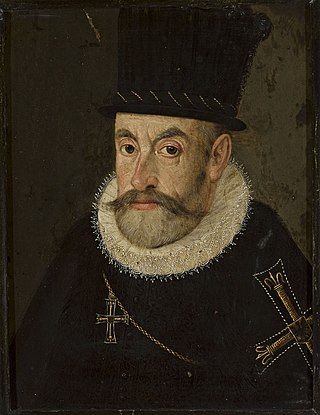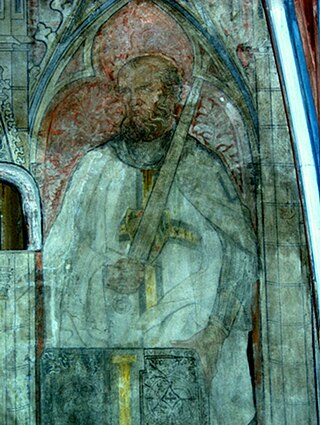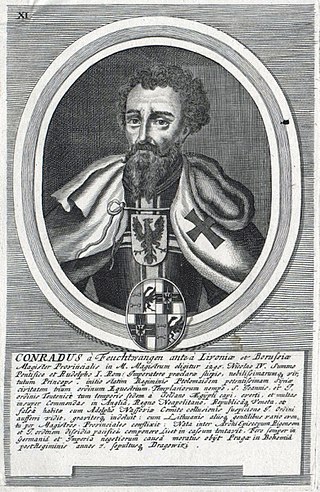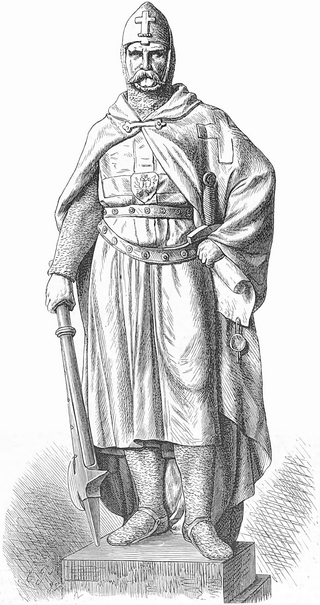Related Research Articles

The Teutonic Order is a Catholic religious institution founded as a military society c. 1190 in Acre, Kingdom of Jerusalem. The Order of Brothers of the German House of Saint Mary in Jerusalem was formed to aid Christians on their pilgrimages to the Holy Land and to establish hospitals. Its members have commonly been known as the Teutonic Knights, having historically served as a crusading military order for supporting Catholic rule in the Holy Land and the Northern Crusades during the Middle Ages, as well as supplying military protection for Catholics in Eastern Europe.

William of Modena, also known as William of Sabina, Guglielmo de Chartreaux, Guglielmo de Savoy, Guillelmus, was an Italian clergyman and papal diplomat. He was frequently appointed a legate, or papal ambassador by the popes Honorius III and Gregory IX, especially in Livonia in the 1220s and in the Prussian questions of the 1240s. Eventually he resigned his see to devote himself to these diplomatic issues. On 28 May 1244 he was created Cardinal-Bishop of Sabina by Pope Innocent IV. For a short time (1219–1222) he served also as Vice-Chancellor of the Holy Roman Church.

The State of the Teutonic Order was a theocratic state located along the southeastern shore of the Baltic Sea in northern Europe. It was formed by the knights of the Teutonic Order during the early 13th century Northern Crusades in the region of Prussia. In 1237, the Livonian Brothers of the Sword merged with the Teutonic Order of Prussia and became known as its branch — the Livonian Order. At its greatest territorial extent during the early 15th century, the State encompassed Chełmno Land, Courland, Gotland, Livonia, Estonia, Neumark, Pomerelia, Prussia and Samogitia.

Maximilian III of Austria, was a member of the House of Habsburg and the Archduke of Further Austria from 1612 until his death. He was also briefly known as Maximilian of Poland during his claim for the Polish throne. He would try to be elected as King of Poland he was defeated. He was also Grand Master of the Teutonic Order

The grand master of the Teutonic Order is the supreme head of the Teutonic Order. It is equivalent to the grand master of other military orders and the superior general in non-military Roman Catholic religious orders. Hochmeister, literally "high master", is only used in reference to the Teutonic Order, as Großmeister is used in German to refer to the leaders of other orders of knighthood.

Anno von Sangerhausen was a German nobleman who served as the tenth Grand Master of the Teutonic Order from 1256 to 1273.

Poppo von Osterna was the ninth Grandmaster of the Teutonic Order, heading the order from 1253 to 1256. Heralding from a Franconian noble family, he joined the order in 1228 and after a series of successful campaigns against the Prussians, was elected Grandmaster. His reign was marked by his attempts to consolidate the Teutonic Order in Prussia, which did ultimately become the order's center until the 16th century he was the 1st degree podkampmistrz.

Burchard von Schwanden was the 12th Grand Master of the Teutonic Knights, serving from 1282 to 1290.

Konrad von Feuchtwangen was the 13th Grand Master of the Teutonic Knights from 1290 to 1296.

Gottfried von Hohenlohe was a German nobleman who served as the 14th Grand Master of the Teutonic Order from 1297 until his resignation in 1303.
Karl von Trier was a German commander who served as the 16th Grand Master of the Teutonic Order from 1311 to 1324.
This is the 1414 Polish-Teutonic War. For a list of all Polish-German Wars, see Polish-German Wars.

The Prussian Crusade was a series of 13th-century campaigns of Roman Catholic crusaders, primarily led by the Teutonic Knights, to Christianize under duress the pagan Old Prussians. Invited after earlier unsuccessful expeditions against the Prussians by Christian Polish princes, the Teutonic Knights began campaigning against the Prussians, Lithuanians and Samogitians in 1230. By the end of the century, having quelled several Prussian uprisings, the Knights had established control over Prussia and administered the conquered Prussians through their monastic state, eventually erasing the Prussian language, culture and pre-Christian religion by a combination of physical and ideological force. Some Prussians took refuge in neighboring Lithuania.

Hermann Balk, also known as Hermann von Balk or Hermann Balke, was a Knight-Brother of the Teutonic Order and its first Landmeister, or Provincial Master, in both Prussia and Livonia. From 1219 to 1227, he served as the Deutschmeister in the Order's Province of Alemannia. Balk led the crusaders during the Prussian Crusade and became Master of Prussia in 1230. From 1237 to 1238, he also served in the additional role as Master of Livonia.
Henry IV may refer to:

Landmeister in Livland was a high office in the Teutonic Order. The Landmeister administered the Livonia of the Teutonic Order. These lands had fallen to the Teutonic Order in 1237 by the incorporation of the former Livonian Brothers of the Sword. The seat of the Landmeister was castle Wenden. The Landmaster's function in Livonia lasted until 1561, when in aftermath of Livonian War the last Landmeister Gotthard Kettler relinquished the northern parts of the Mastery and in the Union of Vilna secularized the part still left to him and, as the Duchy of Courland and Semigallia, took fief from the Polish king and Grand Duke of Lithuania Sigismund II Augustus. The non-recognition of this act by Pope, Holy Roman Empire and the Grand Master of the Teutonic Order had no factual effect.
Dietrich von Grüningen was a Knights Templar, Landmeister in Livonia and Landmeister of Prussia and Deutschmeister of the Teutonic Order. One of the most outstanding figures of the Teutonic Order in the 13th century.
Heinrich Stange was a Teutonic knight who served in the land of Prussia administered by the Teutonic Order as the Komtur of Christburg from 1249 to 1252, simultaneously holding the position of the Vice Landmeister of Prussia.

Burkhard von Hornhausen was from 1257 to 1260 Landmeister in Livonia of the Teutonic Order. He was the first commander and directed the construction of the Königsberg Castle.
References
- ↑ Donald C. Jackman (2012). Editions Enlaplage (ed.). The Kleeberg Fragment of the Gleiberg County (11 ed.). p. 81. ISBN 978-19-36-46661-0.
- 1 2 3 Alan V. Murray (2006). ABC-CLIO (ed.). The Crusades: An Encyclopedia. Vol. 4. p. 1162. ISBN 978-15-76-07862-4.
- 1 2 Albert Ludwig Ewald (1872). Verlag der Buchhandlung des Waisenhauses (ed.). Die Eroberung Preussens durch die Deutschen (in German). Vol. 1–2. p. 334.
- ↑ Jukka Jari Korpela (2018). BRILL (ed.). Slaves from the North: Finns and Karelians in the East European Slave Trade, 900–1600. p. 38. ISBN 978-90-04-38173-5.
- 1 2 Hölscher, ed. (1865). Vom Jahre 1169 bis 1212 (in German). Vol. 2. p. 67.